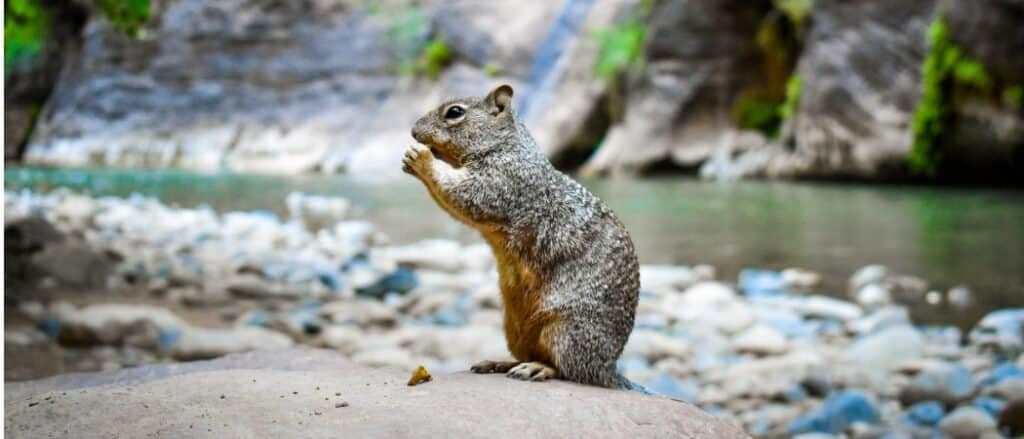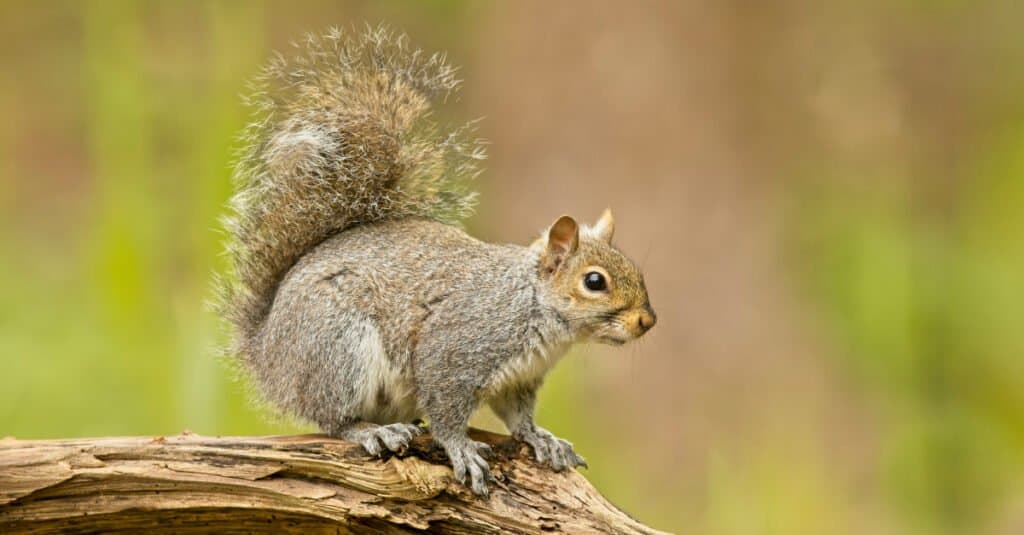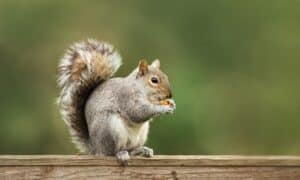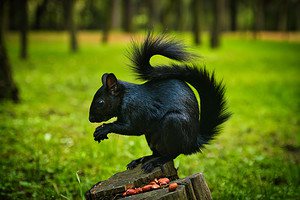Is there any rodent species more ever-present and loved by humans than the adorable squirrel? These delightfully curious and social furry animals love to hang out in our backyards and gardens as well as in urban areas like cities and neighborhoods, and they’ve adapted over time to eat a wide variety of foods to survive and thrive.
Squirrels are part of the Sciuridae family, which is mostly made up of small rodents like chipmunks, prairie dogs, groundhogs, and, of course, both tree- and ground-dwelling squirrels. There are over 200 species of squirrels that exist all around the world, ranging in size from the tiny pygmy squirrel to the massive black giant squirrel, and their diets are just as diverse.
Here’s a detailed look at the typical squirrel’s diet, as well as the fascinating ways in which these rodents are able to locate and store their food so they can survive through the cold and unforgiving winter months.
What Squirrels Eat

Squirrel eating by the water
©iStock.com/Gabriel Mash
Squirrels are technically omnivores, which means they eat both plant and animal matter. However, they tend to strongly prefer foraging for more plant-based foods that are rich in carbs, fats, and protein, such as nuts, fruits, and grains. Squirrels only eat other animals like mice and lizards when they are desperate and can’t find anything else to eat.
Still, though, they’re highly opportunistic and surprisingly skilled problem solvers, so they’ll happily chow down on any of the following foods they manage to find in their many varied habitats:
- Nuts of any kind, i.e. peanuts, walnuts, almonds, cashews, hazelnuts, etc.
- Fungi like truffles and oyster mushrooms
- Seeds
- Roots
- Grains
- Grasses and leaves
- Small fruits, primarily wild berries
- Insects like caterpillars and crickets
- Bird eggs
- Mice, usually smaller species and baby mice (rarely)
- Vegetables like corn and squash
- Leafy greens, such as kale, spinach, and lettuce
- Flowers
- Small lizards and snakes (rarely)
Although squirrels are unable to properly digest cellulose (an organic compound found in most green plants), they will still often eat many grasses, flowers, and other plants.
This is especially true during early spring, because most of the nuts they stocked up on over the winter have started sprouting or rotting away, and a lot of the other foods they eat like fruits and vegetables aren’t readily available until the warmer months.
Additionally, urban squirrels will frequently eat food scraps found in dumpsters and around areas where humans congregate, though this isn’t very beneficial to their health and is more of a survival tactic.
How Do Squirrels Find Food?

Squirrels rely on their sense of smell to find the caches in which they hoard their food.
©iStock.com/birdsonline
Squirrels have an excellent sense of smell and very good vision, both of which they rely on to scout out their favorite food sources, primarily nuts, seeds, fruits, and vegetables.
To survive the harsh winter months, many squirrels will bury food in various locations in the warmer seasons so they can come back to it later. This way, they have a steady supply of food, even when things start to get tough and most of the things they eat become exceedingly scarce.
Their keen sense of smell is also part of the reason why they are able to find where they’ve hoarded and buried their food! Scent isn’t the only way they track down the nuts and other goodies they’ve buried, though; studies have shown that many species of squirrels are actually able to remember and return to distinct food cache locations from weeks or even months prior.
Read More About Squirrels on A-Z Animals
- Japanese Squirrel
- Red Squirrel
- Indian Palm Squirrel
- Indian Giant Squirrel (if you’ve never seen it you have to take a look!)
- Do Grey Squirrels Hibernate?
- Why Do Squirrels Chase Each Other?
- The Differences Between Squirrels vs. Chipmunks
- Fly Squirrel
The photo featured at the top of this post is © iStock.com/Gabriel Mash
Thank you for reading! Have some feedback for us? Contact the AZ Animals editorial team.






